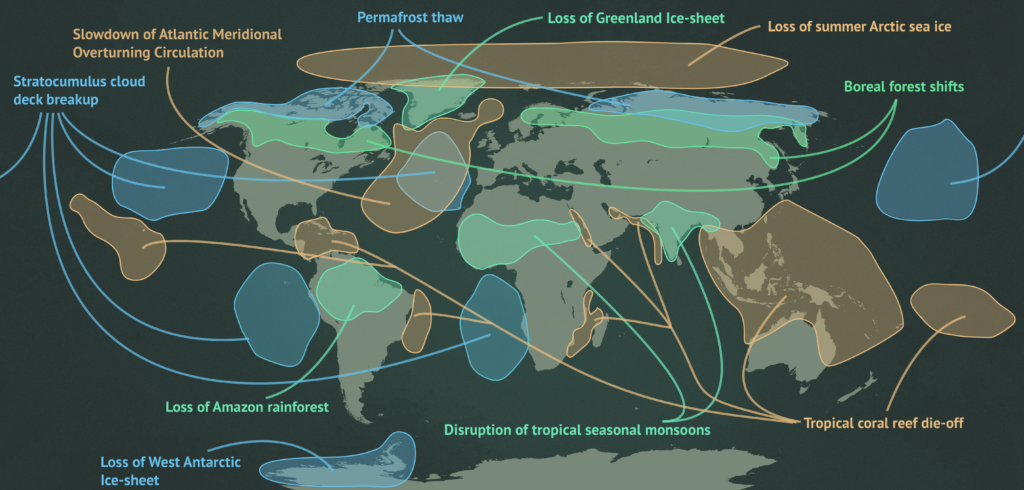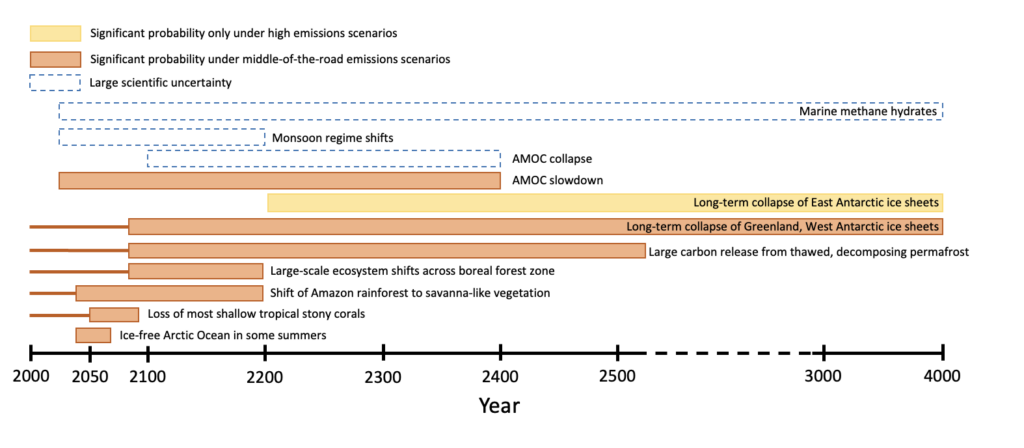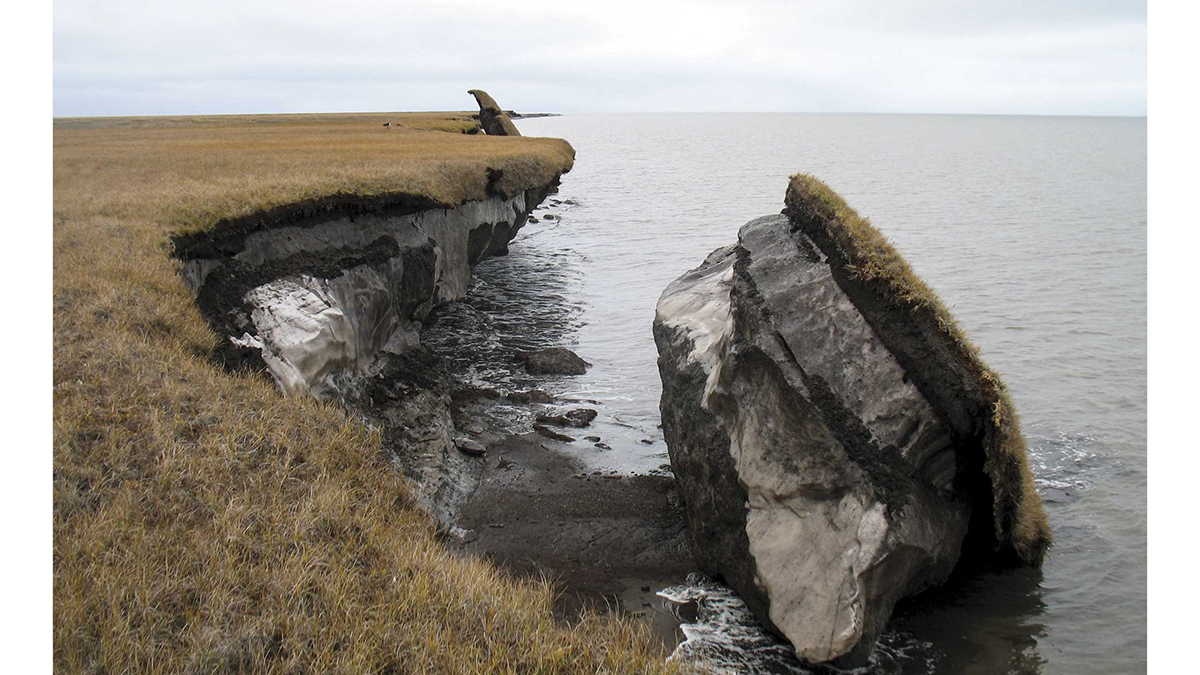Editors’ Vox is a blog from AGU’s Publications Department.
For many different Earth processes, ecosystems, and parts of the Earth system, an additional increment of global temperature change causes a corresponding small change in that process or system. For instance, gradual warming of air temperatures gradually increases the water vapor amount that air can hold.
In contrast, “tipping elements” may exhibit one or several thresholds where a small change in a variable produces a large change in response. That change may happen quickly, like when rainfall in a tropical forest falls beneath the level needed to sustain some tree species, causing them to die within decades and change the composition of the ecosystem. Alternatively, such changes can happen very slowly, as is the case for destabilized ice sheets that may take several centuries to slide towards the coastline before breaking into fragments and melting.
A recent study in Reviews of Geophysics summarizes the current scientific understanding of ten potential tipping elements of the Earth’s climate system. We asked the lead author to give an overview of these tipping elements, how they are evaluated, and what questions remain.
Why do you advocate for using the term “tipping element” instead of the more commonly used “tipping point”?
The term “tipping element” helps avoid confusion as it refers more directly to the element of the Earth system in question.
In conversations about climate change, a lot of writers and commentators confuse a “tipping point,” which refers to a critical threshold like temperature for a system, with that larger system itself, such as Arctic permafrost soils or Arctic sea-ice. The term “tipping element” helps avoid some of this confusion as it refers more directly to the element of the Earth system in question, making it clearer that a “tipping point” indicates the point beyond which that system begins to undergo a large-scale shift.
Additionally, the term “tipping point” often conveys the impression that a critical threshold is precisely known, that a system “tips” very abruptly once this threshold is crossed, and that this single threshold governs an ecosystem that may be vast and complex and dependent on multiple thresholds. In practice, not all—if indeed any—of these conditions may necessarily be true for a given tipping element.
What are some of the challenges of evaluating tipping elements?
Tipping elements pose a number of hurdles to researchers trying to study them. First, these are often large, complex systems, sometimes spanning one or many continents. For a given tipping element, climate change may influence several different feedbacks and mechanisms at once, with effects that sometimes oppose one another. Scientists are often still trying to tackle knowledge gaps related to many of these questions. This makes tipping elements very difficult to model accurately. Second, the size and complexity of tipping elements also makes it hard for researchers to use field studies or experiments to assess their vulnerability to climate change, as conditions may differ widely across different landscapes and regions. Finally, evidence of how tipping elements responded to changes in Earth’s past climate may be sparse, making it particularly difficult to determine how abruptly past changes occurred or what thresholds may have governed such changes.

What are the ten tipping element candidates explored in your review?
On land, we explored the key considerations and questions related to long-term loss of major ice sheets on Greenland and in Antarctica, large-scale ecosystem shifts for the Amazon rainforest and northern evergreen forests, and how much greenhouse carbon thawing permafrost soils might release.
Several tipping elements involve changes to ocean systems, like species loss for coral reefs, shrinking Arctic sea-ice, and potential weakening of the Atlantic Meridional Overturning Circulation—a major ocean circulation pattern in the North Atlantic with important implications for climate patterns and the movement of ocean waters. We discussed why frozen methane locked in seafloor sediments is likely quite resilient to climate change.
We also reviewed a couple proposed atmospheric circulation changes, and explained why theories regarding abrupt shifts to monsoon patterns have faded over time. We also described an uncertain new theory that clouds shielding much of the ocean from sunlight could dissipate at very high CO2 levels.
What criteria did you use to evaluate these ten candidate tipping elements?
We sought to summarize existing research to help address a number of important questions. What processes and interactions drive each system? What shifts have researchers observed so far? Is there evidence that a system changed significantly in response to a critical threshold in the past? Has scientific understanding of the system changed or improved as the research community has continued to study it?
Looking ahead, what do models say about the possibility of critical thresholds, where they might be, and how each system could change in response to different levels of future warming? How fast or slow would the system respond to the influence of climate change? What would the implications of these changes be for other natural systems and for human communities? Would it be possible to reverse these changes if the climate were to cool back down to its pre-industrial temperature level? Finally, what unanswered questions remain for future research efforts to tackle?
What is a “tipping cascade”?
A “tipping cascade” involves a possible set of interactions in which physical climate factors might cause one or more tipping elements to transition into a new state, causing further climate shifts that in turn push other tipping elements across their critical thresholds. For instance, melting of the Greenland ice sheet could increase flows of freshwater into the North Atlantic, causing ocean circulation patterns to change and affecting how ocean currents move water and heat globally. Such potential interactions remain very uncertain, may unfold over relatively long timescales of a couple centuries or more, and depend heavily upon which tipping elements are fast-acting versus slow-acting.
The possibility of tipping cascades is concerning and requires further study. However, most research suggests that continued human greenhouse gas emissions influence tipping elements significantly more than the smaller climate feedbacks that tipping elements themselves are likely to participate in. Future scenarios where society considerably limits and reduces greenhouse gas emissions will reduce climate risks associated with both tipping elements and their possible interactions.

Which tipping elements could start experiencing major changes this century?
Tropical coral reefs are very sensitive to climate change and many reef-building species may face existential risks even at 1.5oC of warming. The Amazon rainforest faces pressure from reduced rainfall, increased wildfires, and human burning and logging, and could be nearing important ecosystem thresholds. Climate change is already driving shifts in northern evergreen forests and causing thaw across large areas of frozen soil, and such changes could accelerate over the next few decades.
Moderate warming this century could also trigger future permafrost carbon release and long-term degradation of ice sheets in Greenland and Antarctica that would progress over several centuries and beyond. Uncertainties in climate models make it difficult to predict the size of possible changes in ocean circulation over this century, and so the risk of large-scale shifts in North Atlantic Ocean patterns cannot be ruled out.
What are some of the unresolved questions where additional research, data, or modeling are needed?
Studying Earth’s climate in the distant past remains difficult but can help us determine how tipping elements may have responded to climate shifts over the course of Earth’s history.
Studying Earth’s climate in the distant past remains difficult but can help us determine how tipping elements may have responded to climate shifts over the course of Earth’s history. Meanwhile in the present day, high-volume data collection from sensors, drones, and satellites coupled with techniques like machine learning can provide more insight into how vast, complex ecosystems function.
Better modeling capabilities are another important priority. For example, researchers are working to improve how climate models represent key ocean circulation patterns in the North Atlantic, and how vegetation models predict potential changes to forest ecosystems in response to further warming. Over time, advances in computing may allow scientists to run more realistic, fine-grained models further into the distant future, enabling more accurate simulations. This could be particularly useful for studying the possibility of tipping element interactions.
Given that several tipping elements are potentially sensitive to small changes in future warming, more modeling efforts that explore a wider range of long-term low-warming and medium-warming scenarios can also help provide more precise information about their critical thresholds.
—Seaver Wang ([email protected]; ![]() 0000-0001-9792-4602), The Breakthrough Institute, USA
0000-0001-9792-4602), The Breakthrough Institute, USA
Editor’s Note: It is the policy of AGU Publications to invite the authors of articles published in Reviews of Geophysics to write a summary for Eos Editors’ Vox

